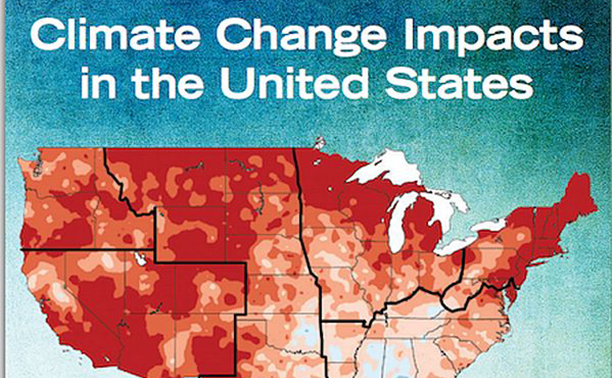
U.S. National Climate Assessment released
by Tim Willmott : Comments Off on U.S. National Climate Assessment released
This week, the White House released the 3rd U.S. National Climate Assessment (NCA) – the most comprehensive scientific assessment ever generated of climate change and its impacts across every region of America and major sectors of the U.S. economy.
The findings in the NCA underscore the need for urgent action to combat the threats from climate change, protect American citizens and communities today, and build a sustainable future. Developed over four years by our nation’s top climate scientists and technical experts, the NCA represents the most authoritative and comprehensive knowledge base about how climate change is affecting America now, and what’s likely to come over the next century.
Climate Trends in America
- Temperature: “U.S. average temperature has increased by 1.3°F to 1.9°F since record keeping began in 1895; most of this increase has occurred since about 1970. The most recent decade was the Nation’s warmest on record. Temperatures in the United States are expected to continue to rise. Because human-induced warming is superimposed on a naturally varying climate, the temperature rise has not been, and will not be, uniform or smooth across the country or over time.” (NCA Highlights: Climate Trends)
- Extreme Weather: “There have been changes in some types of extreme weather events over the last several decades. Heat waves have become more frequent and intense, especially in the West. Cold waves have become less frequent and intense across the Nation. There have been regional trends in floods and droughts. Droughts in the Southwest and heat waves everywhere are projected to become more intense, and cold waves less intense everywhere.” (NCA Highlights: Climate Trends)
- Hurricanes: “The intensity, frequency, and duration of North Atlantic hurricanes, as well as the frequency of the strongest (Category 4 and 5) hurricanes, have all increased since the early 1980s. The relative contributions of human and natural causes to these increases are still uncertain. Hurricane-associated storm intensity and rainfall rates are projected to increase as the climate continues to warm.” (NCA Highlights: Climate Trends)
- Severe Storms: “Winter storms have increased in frequency and intensity since the 1950s, and their tracks have shifted northward over the United States. Other trends in severe storms, including the intensity and frequency of tornadoes, hail, and damaging thunderstorm winds, are uncertain and are being studied intensively.” (NCA Highlights: Climate Trends)
- Precipitation: “Average U.S. precipitation has increased since 1900, but some areas have had increases greater than the national average, and some areas have had decreases. More winter and spring precipitation is projected for the northern United States, and less for the Southwest, over this century.” (NCA Highlights: Climate Trends)
- Heavy Downpours: “Heavy downpours are increasing nationally, especially over the last three to five decades. Largest increases are in the Midwest and Northeast. Increases in the frequency and intensity of extreme precipitation events are projected for all U.S. regions.” (NCA Highlights: Climate Trends)
- Frost-free Season: “The length of the frost-free season (and the corresponding growing season) has been increasing nationally since the 1980s, with the largest increases occurring in the western United States, affecting ecosystems and agriculture. Across the United States, the growing season is projected to continue to lengthen.” (NCA Highlights: Climate Trends)
- Ice Melt: “Rising temperatures are reducing ice volume and surface extent on land, lakes, and sea. This loss of ice is expected to continue. The Arctic Ocean is expected to become essentially ice free in summer before mid-century.” (NCA Highlights: Climate Trends)
- Sea Level: “Global sea level has risen by about 8 inches since reliable record keeping began in 1880. It is projected to rise another 1 to 4 feet by 2100.” (NCA Highlights: Climate Trends)
- Ocean Acidification: “The oceans are currently absorbing about a quarter of the carbon dioxide emitted to the atmosphere annually and are becoming more acidic as a result, leading to concerns about intensifying impacts on marine ecosystems.” (NCA Highlights: Climate Trends)
The U.S. National Climate Assessment is being released in an interactive, mobile-device-friendly, digital format on www.globalchange.gov. Find the NCA here.
- Read the White House Press Fact Sheet here.
- Tweet about the National Climate Assessment using #ActOnClimate.
- Read the White House blog post with state by state fact sheets here.







Comments are closed